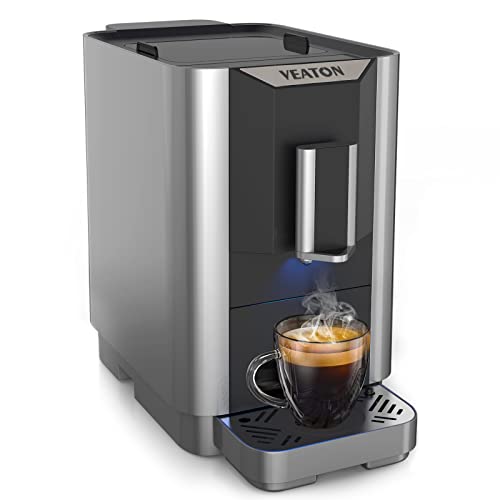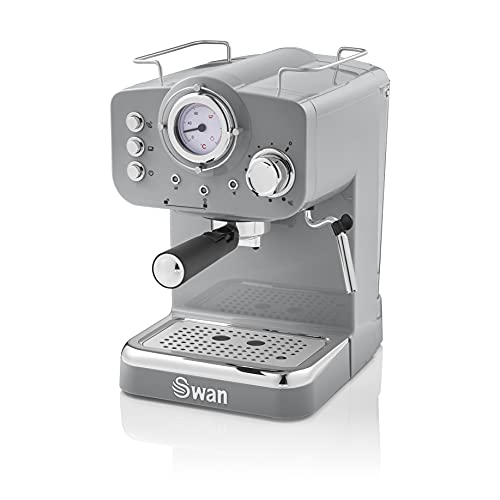Why You Should Concentrate On Enhancing Espresso Machine
페이지 정보
작성자 Shanice 작성일25-02-19 23:50 조회31회 댓글0건관련링크
본문
 Important Parts of an Espresso Machine
Important Parts of an Espresso MachineA quality espresso machine will make a shot of coffee with a dense body that has a full flavor and an intense aroma. This requires high levels of pressure and temperature.
Pay pay attention to the crema. This golden-brown layer gives rich espressos their distinctive flavor and color. There are four types of espresso machines, including semi-automatic, manual and automatic.
Water reservoir
The reservoir of water is the container that houses the water that is cold, filtered and that is fed to the espresso machine. It is usually movable and comes with lids that keep the water clean and free of dust. It is a crucial component of an espresso machine, and should be kept clean to avoid the clogging. To clean it, you can add vinegar to the reservoir and let it run for a few minutes.
The espresso machine uses water to pressurize coffee grounds and extract flavors oils, caffeine and flavors. It also produces crema, the foam. Achille Gaggia invented the first espresso machines, which used pistons and levers for high-pressure making. Gaggia's spring piston levers pushed water through the coffee and into the cup, introducing new terms for what was referred to by consumers as "coffee cream" (crema).
The pump utilizes electricity to push water through the heating element to heat it up to the ideal brewing temperature of 195 degrees Fahrenheit. The pump is usually situated on the bottom of the machine. It is connected to a tube that goes through the heating elements. The tube is also connected at either end to hot-water and cold-water tubes. It also connects to the heating elements that resist heat which are covered with white grease to keep the plate warm.
Pump
The pump is what makes an Compact espresso machine machine work and there are many kinds. Some machines use a vibratory pump or a vibration pump which uses an electromagnetic motor that moves between the sides of a coil with 60 pushes per sec. The pump draws water into the portafilter and then out of the spouts. Some pumps utilize an heating system, known as the thermoblock, or thermocoil, to warm the water precisely to the temperature needed for making. These systems allow for the control of temperature and pressure, which are essential for a high-quality extraction.
Pump-driven espresso machines can employ a piston, spring or electric pump. But, they all require that water be moved through the coffee grounds at high pressure. The higher the pressure, the better the extraction. The pump helps ensure that the coffee ground is evenly dispersed, which helps create a great crema.
Other types of professional espresso machine for home machines include piston-driven or steam-driven. Steam pressure is used to force water through the grounds of coffee in a steam-driven espresso machine. This type of espresso machine is less expensive, but doesn't produce as much pressure for extraction. There are air pump-driven espresso machines that are smaller and lighter and do not require steam boilers. They can be powered with a hand pump or a canister using compressed air (such CO2 or N2). Air-pump-driven espresso machine coffee makers have less pressure than pump-driven espresso machines, but they may be more convenient for Compact Espresso Machine some.
Steam tool
The steam wad is a small metal pipe that shoots hot, steam pressurized into your milk to make foamy drinks like lattes and cappuccinos. You can also use the wand to create hot coffee for espresso machine or cocoa. The wand has several holes that you can turn on or off to regulate the amount of steam released. Some machines have the traditional wand, whereas others have a Pannarello wand that is more simple to operate, but doesn't create the same kind of foam required for Latte art.
If you are having trouble getting your milk to froth, you might be having a problem with the anti-vacuum valve of your espresso machine. The valve was designed in order to prevent air from getting absorbed into the steam wand when it is operating. You can test this by lowering the wand and watching for a hissing sound. If you hear a sound that is hissing it means that air is being drawn into. It is recommended to raise the wand to submerge it fully.
You can also test the valve for anti-vacuum by removing the wand, then cleaning it using warm water and a soft-bristled or soft-bristled sponge. It is crucial to keep the wand clean to avoid clogging, which can affect your frost. If you're not able to fix it yourself, seek help from a technician or the manufacturer.
Control panel
The control panel allows users to alter and configure settings. These include coffee strength as well as volume of milk. These settings are stored in memory and can be modified anytime. The display shows when the machine needs to be descaled, and when the reservoir of water is full.
The majority of professional espresso machine machines have hot water dispensers. This is usually found in between or next to the groups. It can be used to make tea or heat cups, depending on the need. It is also useful for cleaning and rinsing. A lot of models have gauges for pressure on the front of the machine that indicate the current boiler pressure.
A brew switch is also available, which controls both the brew cycle as as the amount of shots. This is crucial because espresso shot size is determined by the amount of time the grounds are in contact with water. The switch can also be used to begin the steaming process if desired.
 The control system on this espresso machine may be a bit outdated, but it is user-friendly. It has a small LCD which feels more like an ordinary LED. It is simple to navigate through the menus. However there is a slight learning curve for those new to the use of espresso machines. The machine's ability to maintain an even temperature is impressive. It keeps a perfect water temperature between 194deg - 208deg F throughout the entire drinking process. This allows for perfect aroma extraction and ensures a consistent, high-quality cup every time.
The control system on this espresso machine may be a bit outdated, but it is user-friendly. It has a small LCD which feels more like an ordinary LED. It is simple to navigate through the menus. However there is a slight learning curve for those new to the use of espresso machines. The machine's ability to maintain an even temperature is impressive. It keeps a perfect water temperature between 194deg - 208deg F throughout the entire drinking process. This allows for perfect aroma extraction and ensures a consistent, high-quality cup every time.댓글목록
등록된 댓글이 없습니다.